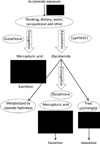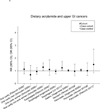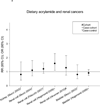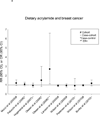Dietary acrylamide and human cancer: a systematic review of literature
- PMID: 24875401
- PMCID: PMC4164905
- DOI: 10.1080/01635581.2014.916323
Dietary acrylamide and human cancer: a systematic review of literature
Abstract
Cancer remains the second leading cause of death in the United States, and the number of cases is expected to continue to rise worldwide. Cancer prevention strategies are crucial for reducing the cancer burden. The carcinogenic potential of dietary acrylamide exposure from cooked foods is unknown. Acrylamide is a by-product of the common Maillard reaction where reducing sugars (i.e., fructose and glucose) react with the amino acid, asparagine. Based on the evidence of acrylamide carcinogenicity in animals, the International Agency for Research on Cancer has classified acrylamide as a group 2A carcinogen for humans. Since the discovery of acrylamide in foods in 2002, a number of studies have explored its potential as a human carcinogen. This article outlines a systematic review of dietary acrylamide and human cancer, acrylamide exposure and internal dose, exposure assessment methods in the epidemiologic studies, existing data gaps, and future directions. A majority of the studies reported no statistically significant association between dietary acrylamide intake and various cancers, and few studies reported increased risk for renal, endometrial, and ovarian cancers; however, the exposure assessment has been inadequate leading to potential misclassification or underestimation of exposure. Future studies with improved dietary acrylamide exposure assessment are encouraged.
Figures









Similar articles
-
[Volume and health outcomes: evidence from systematic reviews and from evaluation of Italian hospital data].Epidemiol Prev. 2013 Mar-Jun;37(2-3 Suppl 2):1-100. Epidemiol Prev. 2013. PMID: 23851286 Italian.
-
Human exposure and internal dose assessments of acrylamide in food.Food Chem Toxicol. 2005 Mar;43(3):365-410. doi: 10.1016/j.fct.2004.11.004. Food Chem Toxicol. 2005. PMID: 15680675
-
Selenium for preventing cancer.Cochrane Database Syst Rev. 2018 Jan 29;1(1):CD005195. doi: 10.1002/14651858.CD005195.pub4. Cochrane Database Syst Rev. 2018. PMID: 29376219 Free PMC article.
-
The Black Book of Psychotropic Dosing and Monitoring.Psychopharmacol Bull. 2024 Jul 8;54(3):8-59. Psychopharmacol Bull. 2024. PMID: 38993656 Free PMC article. Review.
-
Effects of a gluten-reduced or gluten-free diet for the primary prevention of cardiovascular disease.Cochrane Database Syst Rev. 2022 Feb 24;2(2):CD013556. doi: 10.1002/14651858.CD013556.pub2. Cochrane Database Syst Rev. 2022. PMID: 35199850 Free PMC article.
Cited by
-
An eco-friendly solvent-free reaction based on peptide probes: design an extraction-free method for analysis of acrylamide under microliter volume.Anal Bioanal Chem. 2021 Dec;413(30):7531-7539. doi: 10.1007/s00216-021-03717-6. Epub 2021 Oct 11. Anal Bioanal Chem. 2021. PMID: 34635932
-
Comprehensive management of breast augmentation with polyacrylamide hydrogel injection based on 15 years of experience: a report on 325 cases.Ann Transl Med. 2020 Apr;8(7):475. doi: 10.21037/atm.2020.03.68. Ann Transl Med. 2020. PMID: 32395519 Free PMC article.
-
Exploring the traditional Chinese diet and its association with health status-a systematic review.Nutr Rev. 2025 Feb 1;83(2):e237-e256. doi: 10.1093/nutrit/nuae013. Nutr Rev. 2025. PMID: 38452296 Free PMC article.
-
Dietary acrylamide-linked burden of cancers in four sub-sahara African countries: A review and data synthesis.Heliyon. 2023 Dec 12;10(1):e23075. doi: 10.1016/j.heliyon.2023.e23075. eCollection 2024 Jan 15. Heliyon. 2023. PMID: 38169883 Free PMC article. Review.
-
Maternal acrylamide exposure changes intestinal epithelium, immunolocalization of leptin and ghrelin and their receptors, and gut barrier in weaned offspring.Sci Rep. 2023 Jun 24;13(1):10286. doi: 10.1038/s41598-023-37590-3. Sci Rep. 2023. PMID: 37355724 Free PMC article.
References
-
- Tareke E, Rydberg P, Karlsson P, Eriksson S, Tornqvist M. Analysis of acrylamide, a carcinogen formed in heated foodstuffs. J Agric Food Chem. 2002 Aug 14;50(17):4998–5006. - PubMed
-
- Mottram DS, Wedzicha BL, Dodson AT. Acrylamide is formed in the Maillard reaction. Nature. 2002 Oct 3;419(6906):448–449. - PubMed
-
- Stadler RH, Blank I, Varga N, Robert F, Hau J, Guy PA, et al. Acrylamide from Maillard reaction products. Nature. 2002 Oct 3;419(6906):449–450. - PubMed
-
- Elmore JS, Koutsidis G, Dodson AT, Mottram DS, Wedzicha BL. The effect of cooking on acrylamide and its precursors in potato, wheat and rye. Adv Exp Med Biol. 2005;561:255–269. - PubMed
-
- Ishihara K, Matsunaga A, Miyoshi T, Nakamura K, Nakayama T, et al. Formation of acrylamide in a processed food model system, and examination of inhibitory conditions. Shokuhin Eiseigaku Zasshi. 2005 Apr;46(2):33–39. - PubMed
Publication types
MeSH terms
Substances
Grants and funding
LinkOut - more resources
Full Text Sources
Other Literature Sources
